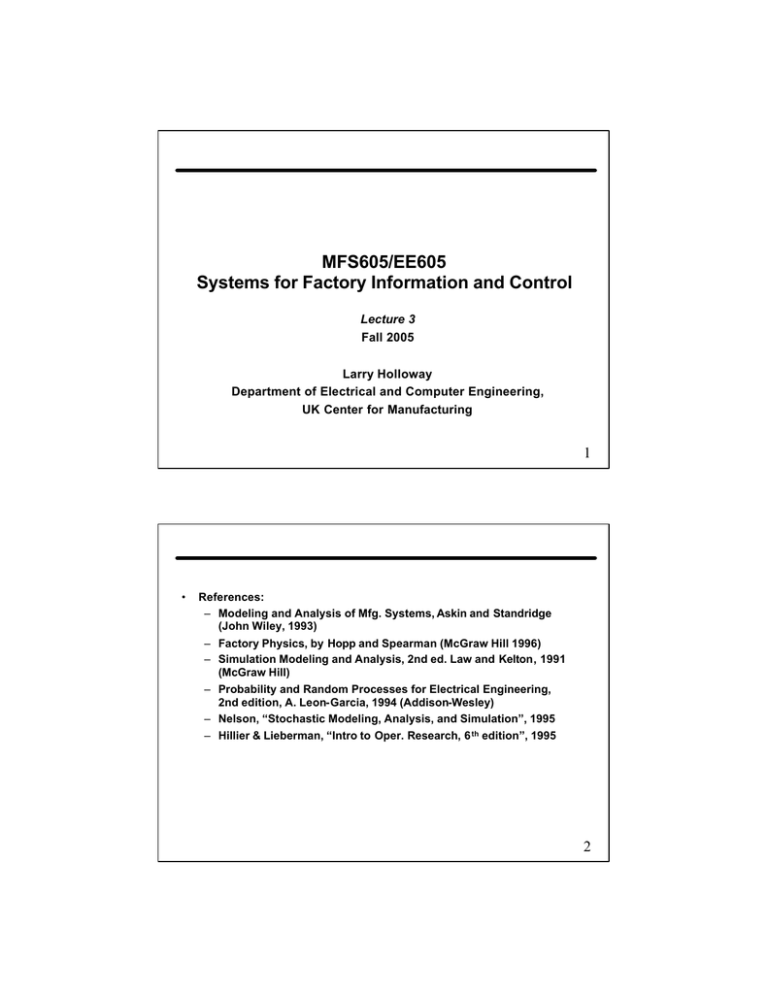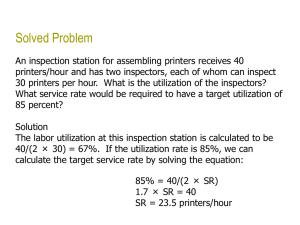MFS605/EE605 Systems for Factory Information and Control 1 Lecture 3
advertisement

MFS605/EE605
Systems for Factory Information and Control
Lecture 3
Fall 2005
Larry Holloway
Department of Electrical and Computer Engineering,
UK Center for Manufacturing
1
•
References:
– Modeling and Analysis of Mfg. Systems, Askin and Standridge
(John Wiley, 1993)
– Factory Physics, by Hopp and Spearman (McGraw Hill 1996)
– Simulation Modeling and Analysis, 2nd ed. Law and Kelton, 1991
(McGraw Hill)
– Probability and Random Processes for Electrical Engineering,
2nd edition, A. Leon-Garcia, 1994 (Addison-Wesley)
– Nelson, “Stochastic Modeling, Analysis, and Simulation”, 1995
– Hillier & Lieberman, “Intro to Oper. Research, 6 th edition”, 1995
2
Previous Class:
Previous Class:
• Considered serial assembly systems
– Paced vs. unpaced
•
Line Balancing Problem
– Given task times and precedence relations, how do we allocate
tasks to least number of workstations?
• Search methods
• RPW
• COMSOAL
• Etc…
But, each of these assumed deterministic task times!
3
Randomness…
Sources of Variability:
•
Natural variation
– operator difference, tool wear, variation of material
•
Breakdown/repair and other unexpected delays
•
Setups and other irregular but expected delays
•
Quality problems…
To study variability/randomness, we need basics of probability…
4
Basic Probability (see appendix A)
Probability
• We have an “experiment” and a set of possible “outcomes”.
• Probability represents notion of “relative frequency”
– how frequently does a given outcome occur given repeated
experiments?
•
Axioms of Probability: Given some subset A of outcomes:
– (a.)
0 ≤ Prob[A] ≤ 1
for any subset A of outcomes
– (b.)
Prob[set of all possible outcomes] = 1
– (c.)
If A and B are mutually exclusive sets of outcomes,
then
Prob[A U B] = Prob[A] + Prob[B]
5
Probability Distributions
•
Random Variable: A map from set of outcomes to the real line
– (assumes some fine restrictions are covered)
– If experiment outcomes are real numbers anyway, then map is
simple.
– Example: processing times, numbers in queue, …
•
Probability Distribution:
– Intuitive notion: integrating between two points gives the
probability of the random variable having value in that range.
Total area = 1
6
Probability Distributions
•
Probability Distributions are either:
– Discrete: random variable only takes on countable number of
possible values (nonzero probability at only specific points)
examples:
– # of parts in buffer
– # of machines needing repair
0.5
– “heads” vs. “tails”
1 2
– Continuous: random variable takes on continuous range of
possible values
examples
– temperature, voltage, pressure
– time to process
– time between customers
1/(b-a)
a
b
7
Expected Value
•
E(X) is expected value of random variable x
Continuous:
E(x) = (a+b)/2
∞
E(x) =∫ xf(x)dx
1/(b-a)
−∞
a
Discrete:
b
E ( x) = ∑ kp(k )
k
0.5
E(x) = 0.5(1)+0.5(2)=1.5
1 2
– expected value of an Rand.Var. is also known as its mean value, µ
• (typically this is the same as the “average value”)
8
Variance
•
Variance of X is: Var(X) = σ2 = E( (x – µ) 2)
– Standard Deviation of X is square root of variance: = σ
Variance indicates spread of the distribution.
•
Example:
•
E(x) = 5
Var(x) =1.33
StdDev = 1.15
1/4
3
5
7
E(x) = 5
Var(x) =5.33
StdDev = 2.3
1/8
1
5
9
9
Poisson Distribution
•
Poisson Distribution:
P{X=k} = ( λ k e− λ ) / k!
– discrete distribution
– parameter λ is expected value (mean) of Poisson random variable X
• “avg rate of occurrences”
• λ = µ, and λ = σ2
– used when events occur “completely at random” in time or space
– Examples:
• # of customers walking into a bank / unit time
• # of customers requesting starting a telephone call over period
• # of failures occurring (or repair requests, etc.)
• # of products with given option requested during period
• # of parts in a batch of random size
• # of parts demanded from inventory
10
Poisson Distribution
•
From Law and Kelton, 1991
11
Continuous Random Variables
Continuous random variables
• --> no probability associated to specific values, instead associated with
intervals of values
– probability is area under curve of distribution function
Uniform Distribution:
E(X) = µ = (a+b)/2
Var(X) = σ2 = (b-a)2 / 12
fX(x) =
1/(b-a) if a ≤ x ≤ b
0
otherwise
E(x) = (a+b)/2
1/(b-a)
a
b
Used as a “first” model for a quantity that is felt to be randomly varying
between a and b, but about which little is known
12
Gaussian (Normal) Distribution:
2
2
1
e − ( x − µ ) / 2σ
2π σ
f X ( x) =
0.5
•
µ is mean = E(x)
σ2 is variance = E((x-m)2)
0.45
0.4
0.35
0.3
0.25
0.2
0.15
0.1
0.05
Example applications:
0
-5
-4
-3
-2
-1
0
Errors of various types
Quantities that are sums of other quantities
1
2
3
4
5
“Central Limit Theorem” says that the sums of independent R.V.s will
approach a normal distribution
(approaches as we increase number of terms in the sum)
Exponential distribution:
•
•
mean = 1/ λ
Var = (1/ λ )2
fX(x) =
0
λ e−λ x
6
13
if x<0
for x ≥ 0
1
0.9
0.8
0.7
0.6
0.5
0.4
0.3
0.2
0.1
0
•
•
0
1
2
3
4
5
6
7
8
9
10
Typically models time between occurrences of events that occur
completely at random but at with constant avg. rate ( λ )
Examples:
– time between initiation and completion of “service”
– time between customer arrivals
– time between failures
14
Poisson vs. Exponential
A process with Poisson arrival distribution has
distributed time between events
exponentially
•
arrival mean of λ parts/hour has
interarrival time mean = 1/ λ (hours/ part)
•
Key point: Memoryless property
– probability of having to wait h more time units before next arrival
is same regardless of when previous arrival occurred.
P[ X > t+h given X>t ] = P [ X > h ]
15
Other Distributions:
Gamma and Wiebull distributions
• Application: time to complete a task, such as customer service or
machine repair (typically done in reasonable time, but sometimes
takes awhile)
• Very versatile by changing parameters
• No negative tail
•
From Law and Kelton, 1991
16
Randomness…(again)
Sources of Variability:
•
Natural variation
– operator difference, tool wear, variation of material
•
Breakdown/repair and other unexpected delays
•
Setups and other irregular but expected delays
•
Quality problems…
17
Coefficient of Variation
Characterizing variation:
• Coefficient of variation:
CV
= (standard deviation) / (mean) = σ / µ .
= sqrt(Variance) / mean
Examples:
18
Handling time variation - synchronous lines
•
Last class: Line balancing of synchronous lines
– Workstation tasks must be done in allotted time C.
– Effectively no buffers
•
What if we have variation in these task times?
•
Possible solutions:
1. (Best solution) Try to reduce/eliminate this variation
2. Accept that sometimes tasks won’t get done:
• Set up emergency response system to help (impractical for fast
lines – so may lead to some starvation or blockages)
• Rework stations
• Line stoppages (“stop the line”)
3. Consider variation slack-time in our balancing
S1
S2
S3
19
Slack Time in Synchronous Lines
•
•
If we knew the probability density function (pdf) for the times, then
we could determine a “max” time for our tasks
“max” is not true max, but is a cutoff covering sufficient probability.
0.5
0.45
0.4
0.35
0.3
0.25
0.2
0.15
0.1
0.05
0
-5
-4
-3
-2
-1
0
1
2
3
4
5
6
Example: Suppose normal
distribution on time.
• From standard normal table we
have:
– For 95% below: less than 1.65
std. deviations above mean
– For 99% below: less than 2.33
std. deviations above mean
– For 99.9% below: less than 3.1
std. deviations above mean
20
– Thus, for probability of at least 95% of being able to complete
tasks within cycle, the time to use is:
E(X) + 1.65*Std.Dev(X)
– Thus, for probability of at least 99% of being able to complete
tasks within cycle, the time to use is:
E(X) + 2.33*Std.Dev(X)
– (Note this can reduce utilization of stations, so it is of course better to
try to remove the variation as much as possible)
•
Example: tasks assigned to station have average time of 60
seconds, with variance of 4. To ensure 99% of time the tasks are
done, we must have cycle time greater than
60 + 2.33 *( 2 ) = 64.66
If we have a cycle time C of 65 seconds, how much idletime
is there on average?
21
•
How reasonable was it to use the normal distribution here?
– Reasonable if the individual task times are normal
or
– Reasonable if the time is sum of other (independent) times
– Why?
•
If we don’t know distribution, we can still consider other ways of
including this slack time to cover variability
22
The need for buffers
•
WIP buffers reduce the impact of stations on each other.
– Starvation
S1
S2
S3
S1
S2
S3
– Blocking
Where are buffers most needed?
23
Random Processing Times without buffers
•
•
Effect of Random Processing Times in balanced, unbuffered lines with no
breakdowns (Askin/Standridge)
CV is Coefficient of Variation = (std.dev.) / mean
24
Example:
• five stages, each with 10 minutes avg. time and CV=1 (std.dev = 10).
Then rate is only 50%.
•
If CV reduced to 0.1 (std.dev. = 1 min.), then rate is at 90%.
•
Observations:
– Throughput decreases as # of stations increase, but then levels
off.
– Reducing CV will reduce our losses.
– We sacrifice output by not having buffers
25
Recovery of lost output from buffering
Z / CV
From Askin and Standridge
26
Definitions (review from class 1)
•
Flow Time is time for an order to move through the system
•
In this class, we use the term Flow Time, Throughput Time, and
Manufacturing Lead Time (Askin&Standridge) to mean the same
thing.
•
Problem: Time spent waiting for machine setup, transportation,
machine availability, etc.
– ---> includes Non-value added activities
– Waiting in queue
– Waiting for transportation
– Waiting for setup
– Flow time directly increases with respect to batch size, and
indirectly due to longer waits for other batches
27
Bottlenecks
•
Bottleneck: The portion of the system that constrains
capacity for the system (least long term capacity).
9 parts/min
8 parts/min
10 parts/min
12 parts/min
Assembly
15 parts/min
8 parts/min
•
•
What is the system capacity?
(Additional Terms: Blocking and Starvation
28
Critical WIP
•
Bottleneck: constrains capacity for the system (least long term
capacity). Let its rate be rb
•
Raw Process Time: T0 : Sum of average process times of
workstations along the line. This is theoretical minimum Mfg. Lead
Time.
•
Critical WIP: W 0 : WIP s. t. when no variability, we have maximum
throughput rate (rb) with minimum time (T0 )
W 0 = rb T0
(This is from Little’s Law of WIP = production rate x throughput time
where we look at max. throughput rate and minimum time
Note: Critical does not necessarily imply “optimal”
29
Implication of Little’s Law
Production Rate
WIP = Production Rate x Throughput Time
capacity
Mfg.Lead Time
WIP
WIP
Implications:
•
If not near capacity, then increasing WIP increases rate without time
increase. (Everything keeps busy).
•
If near capacity, then rate cannot increase more – so increasing WIP
increases throughput time!
30
Example: Penny Fab 1
(from Hopp and Spearman)
Produce giant novelty pennies.
• Process 1: Punch press cuts penny blanks
• Process 2: Stamping of images
•
•
Process 3: Rim put on penny
Process 4: Cleaning and deburring
Suppose two hours per machine (“perfectly balanced”)
24 hours /day
rb = ?
Raw Process Time, T0 = ?
Critical WIP = ?
1
2
3
4
31
Example: Penny Fab 2
(from Hopp and Spearman)
Station no.
# of
Machines
Process
Time
Station
Rate (calc)
1
1
2 hr
0.50 jobs/hr
2
2
5 hr
0.40 jobs/hr
3
6
10 hr
0.60 jobs/hr
4
2
3 hr
0.67 jobs/hr
Station Rate: (#machines)/(time per part per machine)
Bottleneck rate = rb = ?
Total Process Time (excludes waits), T0 = ?
“Critical WIP” = r b T0 =?
1
2
3
4
32
Best Case Performance: Penny fab 1
t=0
t=2
t=4
t=6
1
2
3
4
1
2
3
4
1
2
3
4
1
2
3
4
WIP
Flow Time
%T0
TH rate
%rb
1
8
100
0.125
25
2
8
100
0.250
50
3
8
100
0.375
75
4
8
100
0.500
100
5
10
125
0.500
100
33
Little’s Law
Key Points about Penny Fab 1:
• Once we reach enough WIP for max throughput, then added
WIP just adds to flow time. No added benefit of additional
WIP (in deterministic case)
• WIP below critical level: we lose throughput.
•
This is illustration of Little’s Law:
Throughput rate = WIP / Flow time
à As WIP grows, either throughput rate or flow time grows
à Reducing Flow time means reducing WIP, as long as TH
remains constant
34
Little’s Law applied to Penny Fab 2
•
Little’s law applies at stations or entire line.
Station no.
# of
Machines
Process
Time
Station
Rate
1
1
2 hr
0.50 jobs/hr
2
2
5 hr
0.40 jobs/hr
3
6
10 hr
0.60 jobs/hr
4
2
3 hr
0.67 jobs/hr
Suppose system running at bottleneck rate of .4/hr
• Then station 1 has WIP = rate*FT = .4 j/hr*2hrs = .8 jobs
• Then station 2 has WIP = rate*FT = .4 j/hr*5hrs = 2 jobs
•
•
Then station 3 has WIP = rate*FT = .4 j/hr*10hrs = 4 jobs
Then station 4 has WIP = rate*FT = .4 j/hr*3hrs = 1.2 jobs
1
2
3
4
35
Best Case
Best case (zero variability) performance:
• Minimum flow time for a given WIP given by:
FTbest
=
T0
if w < critical
=
w / rb else
(no waiting)
Maximum Throughput rate for a given WIP given by:
rate best
=
w / T0 if w < critical
=
rb
else
This is the case for PennyFab 1
(perfectly balanced, no variability)
36
Worst Case (impractical)
Worst Case (impractical): Suppose average processing time per station
was same, but actually all the time was spent with the first job.
Note: this is still not random, but we have picked the worst case possible
Example: 1 st job = 8hrs; 2 nd, 3 rd, 4 th take 0 hours.
Then: avg.=2 still, but 4 th job must wait 8 hours at each station!
For given WIP w, define:
FT worst = w T 0
rateworst = 1/T 0
(waiting on all other WIP)
Example: For Penny Fab 1, we have to wait 8 hours each station
For w = 4, Flow time = 8 +8+8+8 = 32 hours = 4*8
Throughput rate = 4/32 = 1/8 jobs / hour
(Note though impractical, this case is somewhat like batching)
1
2
3
4
37
Practical Worst Case
•
Real systems rarely operate like the best or worst case.
•
To consider between the best and worst, we invoke probability.
•
The derivation of this “practical worst case” will be done later. For
now, we present the basic idea:
– All stations perfectly balanced
– All stations are single machines
– Process times are random. In particular, assume that our
system is “memoryless” – so the remaining time for a job at a
station is independent of the time that the job has already been
there.
•
See graphs next page – derivations to be done with queueing
material
38
WIP relationships
•
(Hopp and Spearman, 1996)
Flow time vs. WIP
•
rate vs. WIP
39
Queueing models
•
Queueing Models
– Probabilistic -- primarily steady state averages
– Advantages:
• Analytical solution to problems with randomness &
uncertainty
• --> fast solution (if solution exists or is known!)
– Disadvantages:
• Requires simplifying assumptions
• Best for smaller models
• solutions not always possible
• most suited for steady state analysis
40
Queuing Theory: Basic Terms
•
Queuing Theory: Study of lines, waiting in lines
•
•
Buffer or Queue
Server -- service rate = µ
– machine
– repair
– (sometimes even parts)
•
Customers --- arrival rate = λ
– parts waiting for machining
– machines waiting for repair
– ...
41
•
Issues: What is distribution of arrivals
– What is distribution of service time
– What is policy for selecting next customer?
•
Queuing theory answers
– expected number of customers in system
– expected number of customers in queue
– avg. customer waiting time in system
– avg customer waiting time in queue
– avg. utilization of server
42
Queuing Theory: Basic Terms
•
Queuing Theory: Study of lines, waiting in lines
•
•
Buffer or Queue
Server -- service rate = µ
– machine
– repair
– (sometimes even parts)
•
Customers -- arrival rate = λ
– parts waiting for machining
– machines waiting for repair
– ...
43
Queuing Theory
•
In this course, we focus mostly on simplest queue: M/M/1
– M stands for Markov or Memoryless
– Notation: Arrival Process / Service Process / # of servers
– M/M/1 -->
• Poisson arrivals: (exponential interarrival times)
time distribution = λ e− λ t
for t ≥ 0
λ = mean arrival rate (expected # arrivals / time)
• Exponential service times
time distribution = µ e−µ t
for t ≥ 0
µ = mean service rate (expected # of customers
completing service per unit time.
44
Exponential Assumption
•
Exponential distributions give simplest queuing analysis
•
Is exponential distribution reasonable?
For service time distribution:
– inappropriate if service same over most parts (as if same parts)
– appropriate if variety of customers each requiring different
operations
For Interarrival time distributions:
– Appropriate if customers appear in very random manner
– Inappropriate if customers typically appear in groups, or if
customers may postpone arrival based on length of queue
45
Utilization Assumption
•
We assume λ/µ < 1.
– Why??
ρ = λ/µ is called utilization
46
Birth-Death Model
•
Quantities of interest in queuing theory:
Pn : probability of having n parts in system
W: avg. wait in system
L: avg. number of customers in system
Consider steady-state averages
Assume unbounded queue size
λ
λ
0
λ
1
λ
2
µ
3
µ
λ
4
µ
µ
µ
Consider steady-state averages: --> Freq. of entry to state
same as frequency of departing from state.
47
Deriving Pn from birth-death model
•
Balance Equations: entry freq. = exit freq. for each state.
λ
0
λ
1
µ
•
Insert derivations
λ
2
µ
λ
3
µ
λ
4
µ
µ
48
Results
•
•
P0 = 1 - λ/µ
Pn = (λ/µ)n (1- λ/µ )
= 1−ρ
= ρ n (1−ρ) = ρ n P0
•
Example 1: λ = 5 parts/hr, µ = 10 parts / hr.
•
Example 2: λ = 8 parts/hr, µ = 10 parts / hr.
( for n>0 )
49
Other questions:
•
What is probability that the machine is idle?
•
What is the probability that there are more than 3 customers in
the system?
50
Avg. # of customers
•
L: = avg. number of customers in the system
∞
L = E[ n ] = ∑ nPn
n= 0
L = λ / (µ−λ) = ρ / (1−ρ)
51
Little’s Law
•
W = mean time spent in system
•
Little’s law:
L = λeff W
mean number of customers in system =
effective arrival rate x mean wait time
– Very general result -- not just for M/M/1 queues
mean # in “system” = arrival rate x mean wait in “system”
mean # in queue = arrival rate x mean wait in queue
Why the “effective arrival rate”?
52
•
Nice graphical proof of Little’s Law found in Leon-Garcia, 2nd
edition, pages 502-503.
53
Mean Wait Time in System
• W = mean wait time in system
L=
λ
=
ρ
(µ−λ)
(1−ρ)
•
Little’s law:
•
W=L/λ
•
Examples:
L=λW
= 1 / (µ − λ )
54
Effect of many small vs. single machine
55
•
Example: We have demand rate of 1 part per hour. We want
average lead time per part under 2 hours. How fast a
workstation do we need?
56
Summary of results so far
M/M/1 queue:
- exponential service times
- Poisson arrivals
(service rate = µ )
(arrival rate = λ )
- 1 server, infinite buffer capacity
•
•
P0 = 1 - λ/µ
Pn = (λ/µ)n (1- λ/µ )
= 1−ρ
= ρ n (1−ρ) = ρ n P0
•
L: = mean number of customers in the system
∞
L = E[ n ] = ∑ nPn =
n= 0
•
( for n>0 )
λ
ρ
=
(µ − λ ) 1 − ρ
W:= mean wait time in the system
W=
L
1
1
=
=
λ ( µ − λ ) µ (1 − ρ )
57
Waiting time in Queue and # in Queue
•
W Q : mean waiting time in just the queue
= mean time in system -- mean time in service
W Q = W − 1/µ
•
LQ : mean number of customers in the queue
•
Use Little’s Law:
LQ = λ WQ
Examples:
58
Multiple servers: M/M/c
µ
λ
µ
c servers
µ
λ
<1
cµ
•
Utilization:
•
Basic intuition from birth-death graph (for c=3):
ρ=
λ
0
λ
1
µ
λ
2
2µ
λ
3
3µ
λ
4
3µ
3µ
59
Basic results for M/M/c
•
(table 11.1 from Askin Standridge)
60
Example of M/M/c
Suppose c=2, µ = 5, λ = 8
λ
8
ρ=
=
cµ 10
•
c −1
(cρ )c
( cρ ) n
P0 =
+∑
c! (1 − ρ ) n= 0 n!
−1
−1
(1.6) 2 1. 6
−1
=
2(. 2) + 1+ 1 = (9) = 0.1111
ρ (cρ ) P0 0.8(1.6) 2 ( 0. 111)
=
= 2.84
c! (1 − ρ ) 2
2(.2) 2
λ
L = LQ + = 2.84 + 1.6 = 4.44
µ
L 4.44
W= =
= 0.555
λ
8
LQ 4. 44
WQ =
=
= 0. 355
λ
8
c
LQ =
61
M/M/1/K
•
Finite capacity queues: State probabilities and # in system
λ
µ
System capacity of K
•
Birth-death model
λ
0
λ
1
µ
λ
2
µ
λ
…
3
µ
λ
µ
K
µ
Pi = ρ P0
i
K
K
i =0
i =0
1 = ∑ Pi = ∑ ρ i P0
→ P0 =
1− ρ
1 − ρ K +1
62
ρ
( K + 1)ρ K +1
for ρ ≠ 1
1 − ρ − 1 − ρ K +1
K
L = E[n] = ∑ nPn = K
n= 0
for ρ = 1
2
•
M/M/1/K queues: mean wait in system:
– Note some customers get turned away.
– For Little’s Law, we need effective arrival rate
offered load is measure of demand on system: λ/µ
carried load is actual demand met by system:
λa/µ
λ a = effective arrival rate = λ (1− PK )
L
W=
λa
WQ = W −
1
µ
LQ = WQλ a
note it can be shown this is LQ = L − (1 − P0 )
63
M/M/1/K example
•
Suppose K=6, µ = 1/8, λ = 1/10
Pi = ?
M/M/1/6
P0 = .25307
P1=.20246
P2=.16197
P3=.12957
P4=.10366
P5=.08293
P6=.06634
M/M/1/infinity
P0=.2
P1=.16
P2=.128
P3=.1024
P4=.08192
P5=.065536
P6=.0524288
Total P0 to P6: 1.0
Total P0 to P6: .790284
• Key point: the limited size system turns away parts sometimes
since the M/M/1/infinity system has probability (1-.79)= 21% of being in state
beyond 6.
64
M/G/1 Queues
•
Insert table and equations from page 367
Example from text: λ = 10/week. All distributions with same mean
Key points: the exponential distribution gives the worst case out
the distributions with comparable means. It is thus useful as
a worst case (maximum randomness) estimate.
65
Review:
•
M/M/1 queue:
L = λ / (µ−λ) = ρ / (1−ρ)
W=L/λ
= 1 / (µ − λ )
W Q = W − 1/µ
LQ = λ WQ
•
M/M/1/K
L =
λa = λ (1 - PK )
W = L / λa
W Q = W − 1/µ
LQ = λa W Q
66





